When ChatGPT first came into the picture, it took off like a wildfire. Some were curious and simply played around, testing the limits, while others tried fun prompts. Like many, I was initially skeptical, mainly because the news channels were fear-inducing. “AI will replace people” was a typical headline.
Even after three years of launch, the debate is still ongoing. However, ChatGPT has certainly come a long way. I have been writing about AI tools and developments for the last decade, and studying ChatGPT statistics; I don’t think it will replace human workers. It can write essays and code, generate images, and assist with other tasks to streamline your workflow.
In this article, I’ll reveal 100+ ChatGPT statistics, including its growth, user base, updates, and more. This will give you an idea of its popularity and perceived impact on businesses.
ChatGPT Growth Statistics
OpenAI introduced ChatGPT to the world in late 2022. Since then, the platform has shown no signs of slowing down in maintaining worldwide user interest.
According to a tweet by Sam Altman, CEO of OpenAI, ChatGPT gained one million users within the first five days of its launch. What started as a tool to help with writing, meetings, or coding has evolved into a behemoth, with 400 million weekly active users as of February 2025. That’s up by 33% from 300 million weekly active users two months back, in December (CNBC).
OpenAI aims for a big boost with its partnership with Apple, portfolio expansion, and investment in infrastructure. The platform targets 1 billion ChatGPT users over the coming year, its chief financial officer, Sarah Friar, told the Financial Times (Financial Times).
ChatGPT Users & Demographics Statistics
On March 31, 2025, Sam Altman tweeted that OpenAI added one million users in one hour. That’s due to the recent frenzy around Ghibli mode, which transforms images and videos in the style of the Legendary Japanese film studio. Here are a few ChatGPT user statistics that reveal users, demographics, age, and more:
1. ChatGPT is the 8th most visited website in the world
ChatGPT saw an impressive 4.5 billion website visits in March 2025, only behind the tech giants like Google, YouTube, Facebook, and Instagram. That’s an increase of 16.47% or 643.2 million from the past month. Most of its traffic (76.33%) comes from direct and organic search (16.22%) (SimilarWeb).
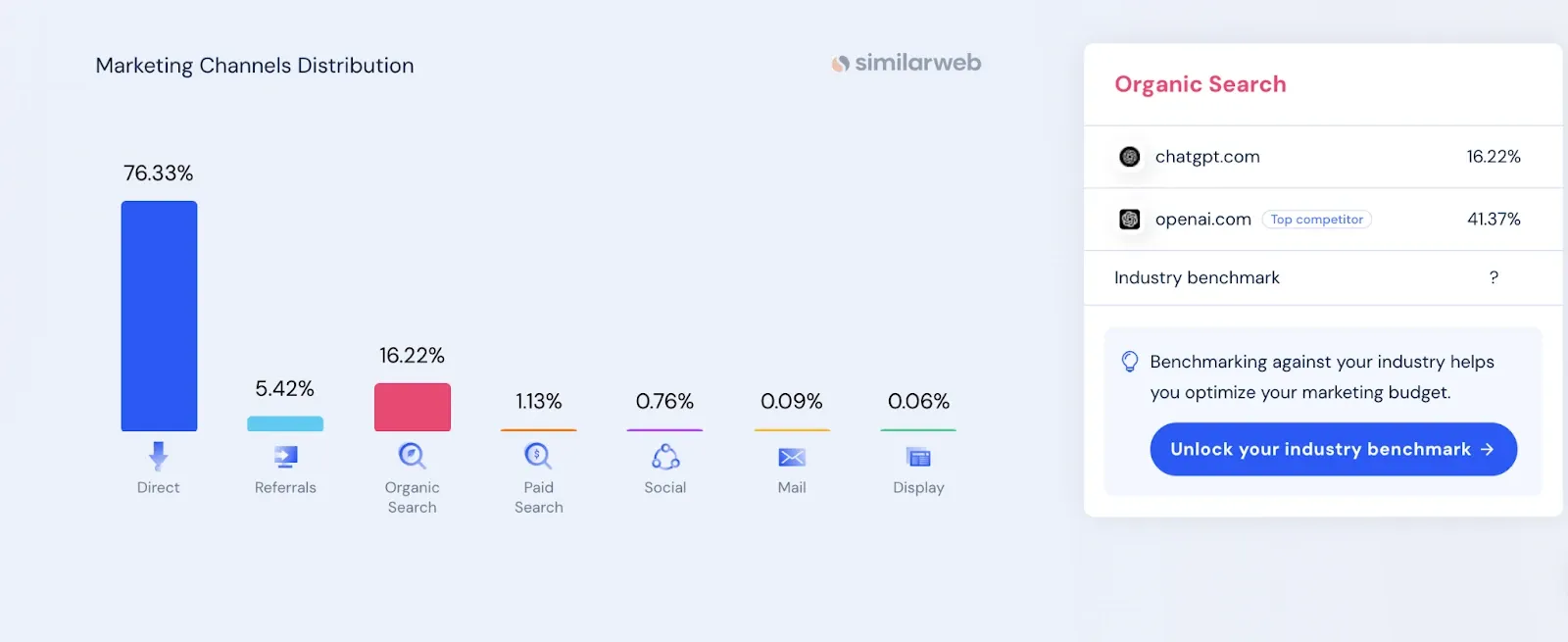
2. ChatGPT has an estimated 67.7 million monthly active users in the US
Although ChatGPT has been publicly available for over two years, there were around 67.7 million monthly US users by the end of 2024. That puts it ahead of popular platforms like Reddit (60.8 million) and X (53.8 million) (eMarketer).
3. Males dominate the gender demographics on ChatGPT
Males form most of the ChatGPT user base, but only by a bit. SimilarWeb shows 53.86% of ChatGPT’s audience is male and 46.14% is female. The numbers indicate an influx of users from all backgrounds for learning, work, and daily use (SimilarWeb).
4. The majority of the audience on ChatGPT is between 18 and 34 years old
The 18-34 year olds on ChatGPT make up 54.2% of the total user base. Meanwhile, mid-career professionals or those between 35 and 54 comprise 32.06% of users. This means more people like me prefer ChatGPT because it saves time and helps them become more productive.
However, usage drops with age, and that’s expected. Most are retired or at the end of their careers; many don’t trust it or find it too complicated. I have heard my grandpa say, “I tried it. I typed in a question, and it wrote me a whole essay. I just wanted a yes or no!” Only 8.46% of users are between 55 and 64, while 5.29% are above 65 (SimilarWeb).
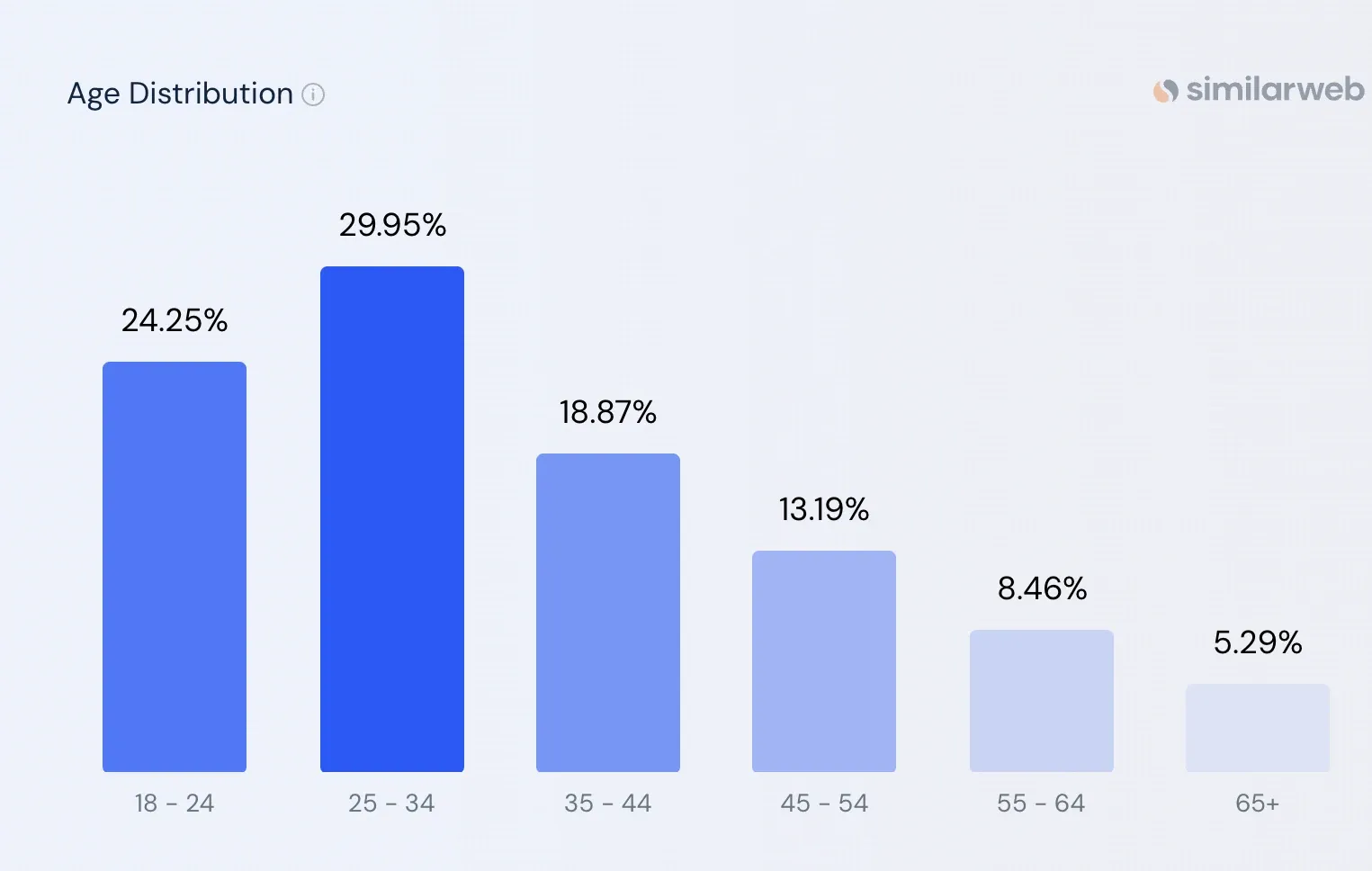
5. The US forms the majority of ChatGPT’s user base
The US recorded the most ChatGPT users (17.92%) as of March 2025, followed by India with 7.96%. This demonstrates a broad adoption of AI tools in other parts of the world, especially among techies, students, and professionals. (SimilarWeb).
Here is a table displaying the share of ChatGPT users by country:
| Country | State of ChatGPT Visitors |
|---|---|
| United States | 17.92% |
| India | 7.96% |
| Brazil | 4.93% |
| United Kingdom | 3.54% |
| Canada | 3.5% |
| Others | 62.14% |
ChatGPT Usage Statistics
Whether I consider ChatGPT a friend or foe, it gives me an edge when used right. I can spend hours ideating, brainstorming, and solving problems on ChatGPT. The benefit: it saves time, provides valuable input, and increases productivity. Here are a few key usage statistics you must know:
- Since its launch, the average engagement time of users on ChatGPT has increased significantly. By the latest recorded month, the average usage time is around 13 minutes and 34 seconds, or 815 seconds per visit (Statista).
- People tend to spend more time on ChatGPT. In March 2025, ChatGPT had a bounce rate of 41.13%, lower than the average of around 48.7% for the top-visited websites (Semrush).
- On average, visitors browse 4.1 pages of ChatGPT per visit, which is lower than the 5.73-page average for top-visited websites. For instance, Instagram users explore 9.46 pages on a single visit (Semrush).
ChatGPT Market Share Statistics
I have seen ChatGPT grow over the years. What was science fiction a few years ago is now available to individuals and businesses through ChatGPT. I can generate a creative essay, write-up, or image within seconds.
Since its launch, it’s been a major player in the Generative AI market with a 59.7% share. It’s followed by Microsoft Copilot with 14.4% and 13.5% of the AI market share, respectively (FirstPageSage).
| Generative AI Chatbot | Market Share | Estimated Quarterly Growth |
|---|---|---|
| ChatGPT | 59.70% | 8% |
| Microsoft Copilot | 14.4% | 6% |
| Google Gemini | 13.50% | 5% |
| Perplexity | 6.20% | 10% |
| Claude AI | 3.20% | 14% |
| Grok | 0.80% | 12% |
| Deepseek | 0.70% | 7% |
ChatGPT Adoption Statistics
The adoption of ChatGPT is nothing short of phenomenal. Launching new models and features, such as GPT-4o, spiked its adoption rate. If you’re on social media, you must have seen the new Ghibli trend. Almost every other person was using ChatGPT to transform their picture. I won’t lie; I also tried it and was quite amazed by the results.
Not only for fun stuff, ChatGPT adoption in high-skilled occupations is also on the rise. Let’s look at how many people use ChatGPT for assistance in their professions, such as IT, journalism, and marketing.
1. Journalists and Software Developers mostly use ChatGPT at work
ChatGPT can be a good writing assistant or a brainstorming partner. It’s like having another person who answers your questions, provides ideas, and discusses the bottlenecks, even if they aren’t well-qualified. Multiple use cases of ChatGPT are why its adoption rate is so high.
- Most marketing professionals (65%), journalists (64%), and software developers (63%) have used ChatGPT at least once in their work.
- Only 12% of financial advisors use ChatGPT at work. Many say ChatGPT only provides a general idea, and not every response is correct.
- Around 33% of customer service representatives use AI to transcribe calls, analyze feedback, and provide responses (The University of Chicago).
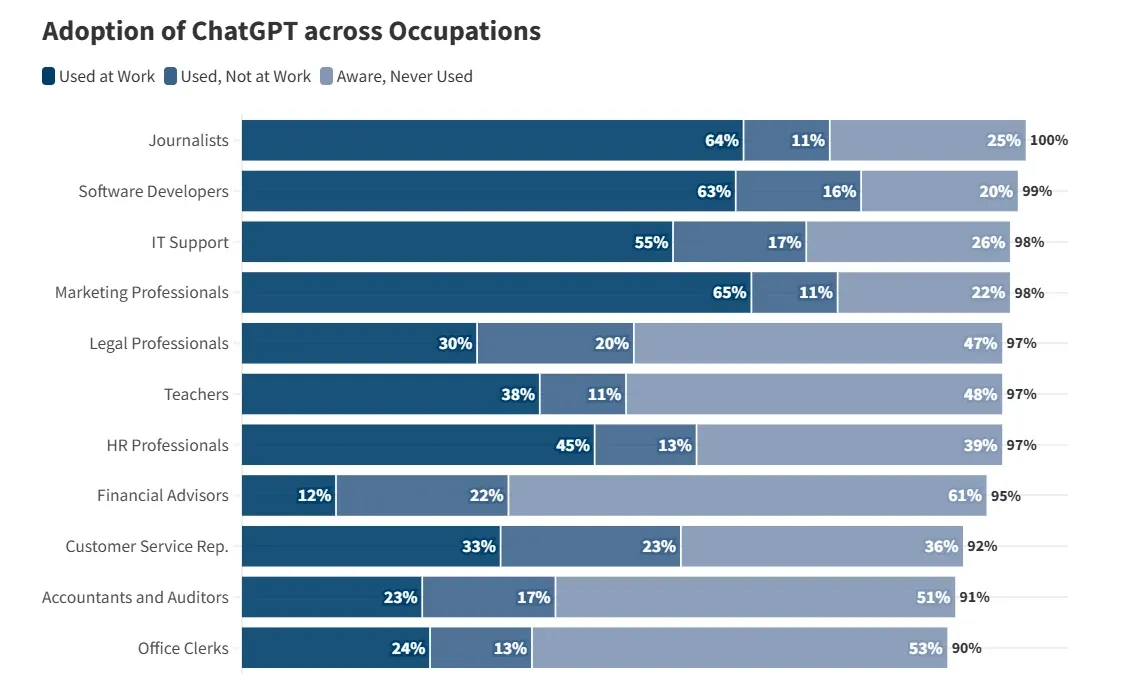
2. Lack of training is what prevents workers from using ChatGPT
You only need a clear prompt with sufficient details to obtain an appropriate response from ChatGPT. However, crafting effective prompts with clear instructions requires training, which many people don’t get.
- Nearly half of women (48%) report needing training to use ChatGPT, while it accounts for 37% of men.
- Men (41%) more often obtain restrictions from their employers regarding using ChatGPT than women (30%).
- A minor percentage of men (10%) and women (11%) feel AI takes away the joy of work. At the same time, 8% of men and 7% of women fear being replaced (The University of Chicago).
3. Education and office-based tasks are the most common use cases of ChatGPT
AIPRM conducted a survey asking 6,000 internet users about how they use ChatGPT. More than 6% have said to use the platform to write extended prose like essays and articles, while 5.4% use it to write emails and letters. Here’s a breakdown of survey respondents who use ChatGPT for various tasks:
| Tasks | Percentage of Users |
|---|---|
| Writing extended prose (essays and articles) | 6.1% |
| Writing emails and letters | 5.4% |
| Creative writing | 4.1% |
| Social media posts | 3.4% |
| Writing speeches | 3.2% |
| Translation | 3.0% |
| Dating apps | 1.9% |
| Job Applications | 1.8% |
| Coding | 1.3% |
| Coursework | 0.9% |
| Cooking | 0.7% |
| Healthcare | 0.2% |
| Others | 1.5% |
| None of the above | 82.8% |
ChatGPT Competitor Statistics
Since ChatGPT became popular, many apps have entered the picture. DeepSeek, a newly launched AI model, is going neck-to-neck with OpenAI. Let’s compare these based on performance, cost, and download to understand which is better.
1. ChatGPT vs Competitors Performance
OpenAI has one of the most robust AI models, as is evident from the ChatGPT user growth chart. The platform expects to gain 1 billion active users at the end of the year. Some of its competitors, like DeepSeek, Claude, and Gemini, come close to it in terms of performance. Here are the comparison details(Arxiv):
- AIME 2024: OpenAI (79.2%) vs DeepSeek (79.8%) vs Claude (16%)
- Math-500: Open AI (96.4%) vs DeepSeek (97.3%) vs Claude (78.3%)
DeepSeek performs better overall, but OpenAI leads in Codeforces rating, percentile, and Aider-Polyglot benchmarks. Here’s a quick look at the numbers:
| Benchmark | OpenAI | DeepSeek |
|---|---|---|
| LiveCodeBench | 63.4% | 65.9% |
| Codeforces Rating | 2061 | 2029 |
| Codeforces Percentile | 96.6% | 96.3% |
| SWE Verified | 48.9% | 49.2% |
| Aider-Polyglot | 61.7% | 53.3% |
3. ChatGPT vs Competitors App Download Statistics
Witnessing the popularity of ChatGPT, most generative AIs have released their Android and iOS apps. However, ChatGPT leads the list with the most downloads over the year:
- In January 2025, ChatGPT became the most downloaded generative AI mobile app worldwide, with over 40.5 million downloads. DeepSeek follows with 17.6 million and Google Gemini with 9.6 million downloads (Statista).
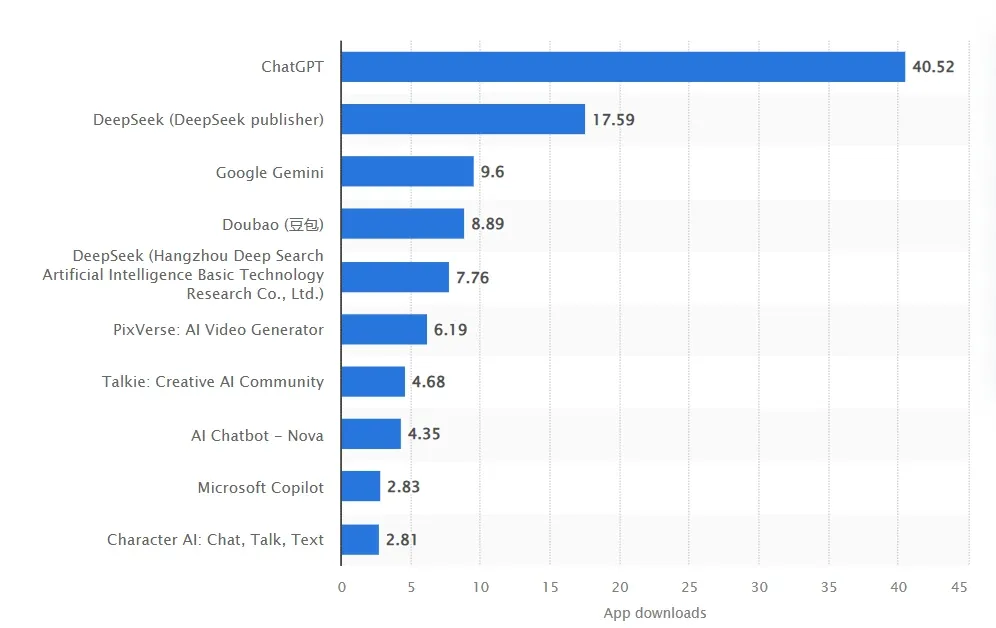
- ChatGPT leads the pack in terms of which generative AI mobile app had the largest downloads within its first 10 days of launch. When it launched on November 30, 2023, it generated over 7.4 million downloads in the first 10 days. It’s again followed by Chinese-developed DeepSeek, with 1.52 million downloads (Statista).
ChatGPT New Features
ChatGPT uses language models to understand your queries and respond accordingly, but it’s far from being a perfect and accurate AI tool. This is why OpenAI constantly works to improve users’ experience. Here are a few ChatGPT statistics regarding its new features:
1. New Shopping Feature: When users make a shopping query, they’ll get relevant product options with images, details, and website links to help them purchase.
For example, if you search for costumes for your dogs, it will consider general criteria like user reviews, price, ratings, and ease of use. Users who previously disliked specific costumes will be excluded from the results.
2. ChatGPT Image Library: In its new update on April 10, 2025, ChatGPT automatically saves the images to a new library. It’s available for free-to-use users on the Web, Android, iOS, and Plus and Pro subscribers. Meanwhile, its Enterprise support is rolling out soon.
3. New UI: OpenAI is rolling out a new UI for desktop, mobile, and macOS, which makes it easier for users to customize responses. You can tell ChatGPT about the traits, how it talks to you, and any rules to follow. This allows users to get more accurate and personalized responses.
4. Projects in ChatGPT: On December 13, 2024, ChatGPT made its Projects feature available to Plus, Team, and Pro users. It enables users to group related files, chats, and custom interactions within a single workspace, making it easier to access relevant information.
5. Face Swapper: ChatGPT’s image generation feature, which was rolled out in March 2025, allows users to swap images with simple prompts. I tried this feature and swapped my face with that of Mark Zuckerberg, Steve Jobs, and others. Although the process is effortless, the results weren’t great.
If you’re a content creator like me and aim to create content that drives engagement, try VidMage. Unlike ChatGPT, the face swap results are excellent. You can choose from several celebrities, historical figures, and fictional characters to face swap with. Also, it supports video face swap, a feature that has yet to be available in ChatGPT.
ChatGPT Price & Plan
In a quest to deliver accurate results, ChatGPT keeps expanding with its new features. But you might wonder how much it costs. ChatGPT has many plans for individuals, small and medium businesses, and enterprises.
- Free Plan: This plan is suited for individuals and one-time users. It provides access to ChatGPT-4o mini, lets you upload files and photos, and ask related questions. It also offers limited access to advanced features like GPT-4o, Advanced Voice Mode, and o3-mini.
- Plus ($20/month): Everything is free, with extended limits on messaging, uploads, and advanced features. It also provides access to deep research models, ChatGPT projects, and a research preview of GPT-4.5.
- Pro ($200/month): Everything in Plus is available, with 120 deep research queries/month, access to o1 pro mode, and OpenAI’s web-browsing agent Operator. You also get priority access to its new features.
- Team ($25 per user/month or $30 per user/month): This plan suits small businesses. It provides a dedicated workspace and admin tools. Users can access everything in the Pro plan and build and share custom apps.
- Enterprise: Suited for large organizations with 149+ licenses. Aside from all the above-mentioned features, it adds enterprise-grade privacy and data analysis capabilities, alongside performance and customization options.
Regardless of the features, ChatGPT has one of the most expensive subscription models. So, I was wondering how many ChatGPT subscribers there are? According to Brad Lightcap, OpenAI COO, ChatGPT has more than 11 million paying subscribers (The Information).
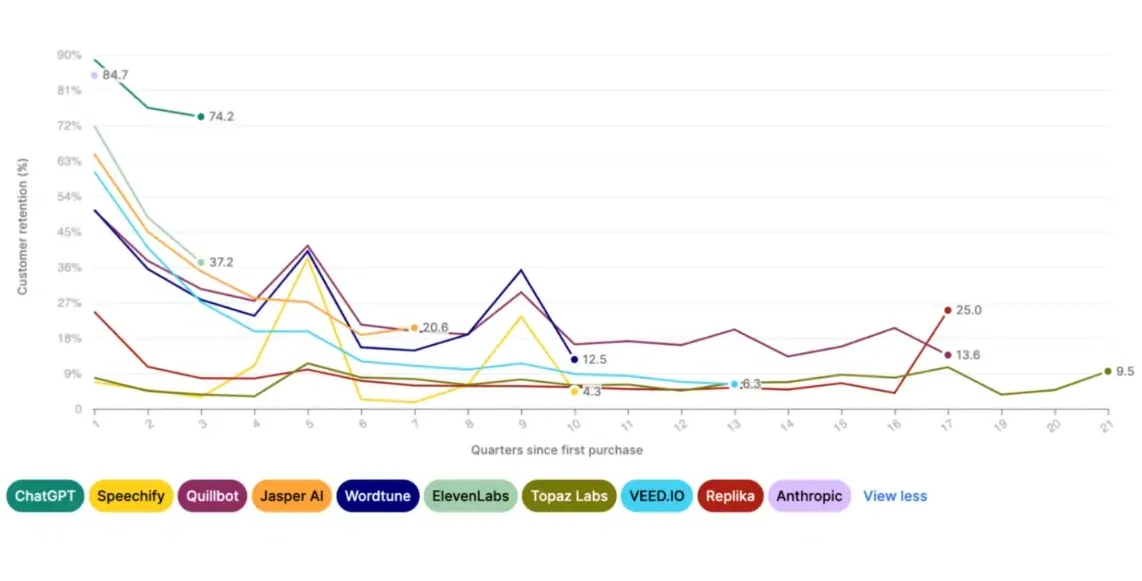
Analysis of credit card data shows that 89% of paying ChatGPT customers still paid after one quarter, and 72% after three quarters. The platform has created the most loyal subscriber base of any AI tool (Earnest Analytics).
OpenAI Statistics
OpenAI, the powerhouse behind ChatGPT and DALL-E, emerged as a leading tech company specializing in Artificial Intelligence (AI). All OpenAI statistics tell a fascinating story about how a company transitions from its beneficial non-profit origins to a profit-driven company.
1. OpenAI has raised an overall of $57.9 billion in funding
OpenAI raised all of its funding in over 11 funding rounds: 1 Seed, 8 Late-Stage, 1 Debt, and 1 Grant (prize money) round. Its largest and latest funding round was a Series F round for $40 billion, led by Softbank Group (Tracxn). The funding was at a $300 billion post-money valuation that, according to OpenAI, helps take AI research to a higher level (OpenAI).
2. OpenAI is one of the most expensive startups
Here’s a list of the world’s most valued companies as of January 2025:
| Company | Valuation (in billions) |
|---|---|
| SpaceX | $350 |
| ByteDance | $300 |
| OpenAI | $175 |
| Stripe | $70 |
| SHEIN | $66 |
| Databricks | $62 |
| Anthropic | $61.5 |
As of March 2025, the latest round of funding with the Softbank Group valued OpenAI at $300 billion (OpenAI). This makes it one of the most valued private companies in the world, just behind Elon Musk’s SpaceX ($350 billion) and on par with ByteDance ($300 billion), the parent company of TikTok (CBInsights).
3. OpenAI expects to triple its revenue this year
OpenAI expects to generate revenue of up to $12.7 billion this year, fueled by the strength of its paid Artificial Intelligence (AI) and increasing ChatGPT monthly active users. That’s around a 240% rise from last year, when the company had an annual revenue of $3.7 billion.
The launch of new features and AI agents fueled the growth, and revenue will continue to rise at a fast clip. OpenAI expects the figures to double next year to $29.4 billion (Bloomberg).
ChatGPT for Developers
In the short time ChatGPT has been around, it has revolutionized many industries, from database management to content creation, healthcare, education, and customer service.
Many people fear AI replacing their jobs, but if you ask me, it’s no less than a blessing for me. Now I no longer need to sit for hours looking for inspiration or prepare a first draft. ChatGPT does it in minutes. Here’s how it benefits developers:
- Code Generation: ChatGPT can write code. It can be your coding assistant, copying your style and natural language to produce programming code. The best part is that most of its code is functional.
- Debugging: Let’s face it—no developer likes debugging. Sometimes, a few days pass in an attempt to eliminate a bug that was created in seconds. ChatGPT can quickly scan thousands of lines within minutes and suggest specific actions to the developers.
- Research and Information Gathering: If you have a programming question about how to solve a particular problem, just ask ChatGPT. It will generate relevant information accordingly.
- A Word of Caution: Although it’s feasible to obtain solutions to complex problems from ChatGPT, it isn’t infallible. In some instances, ChatGPT generates plausible-sounding yet incorrect or nonsensical responses. So, it’s crucial to conduct your research as well.
Conclusion
ChatGPT has undoubtedly come a long way, and with its enhanced capabilities, its user base is expanding. It can take over the mundane tasks, help you ideate, brainstorm, or solve a problem. There are many reasons to be cautious when using ChatGPT, but it’s the same with most AI.
These 100+ ChatGPT statistics are a testament to the fact that AI and ChatGPT are opening a new world for developers, creators, and marketers. If you don’t want to fall behind, it’s time to embrace AI now.
If you want to create high-quality and creative media, opt for AI tools like VidMage. This face swapper tool has all the tools to help you create trendy pictures and videos for your social media. The interface is simple, so creating high-quality content won’t take much effort. So, try it for free now!



